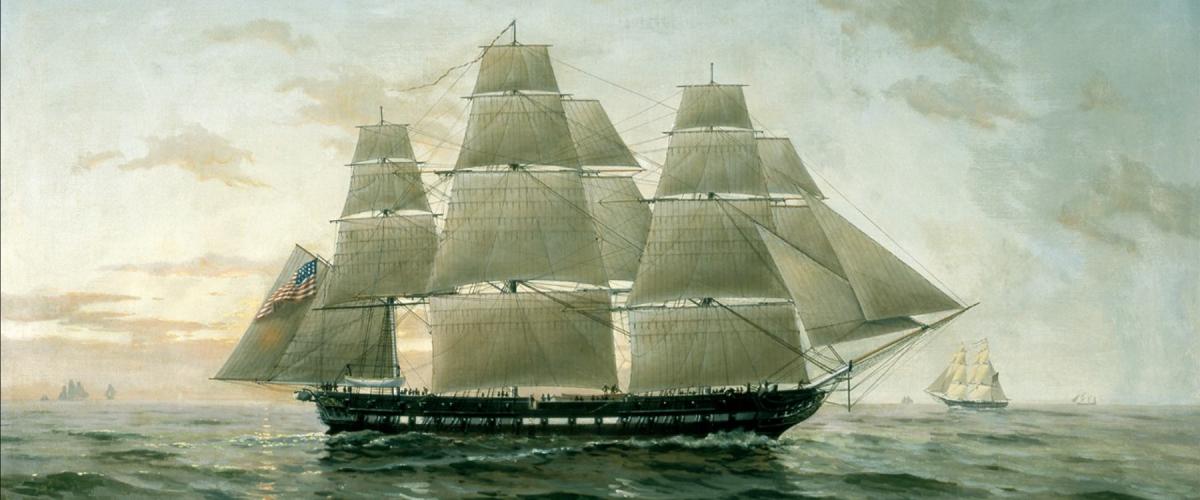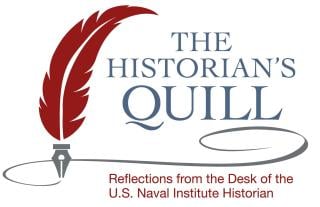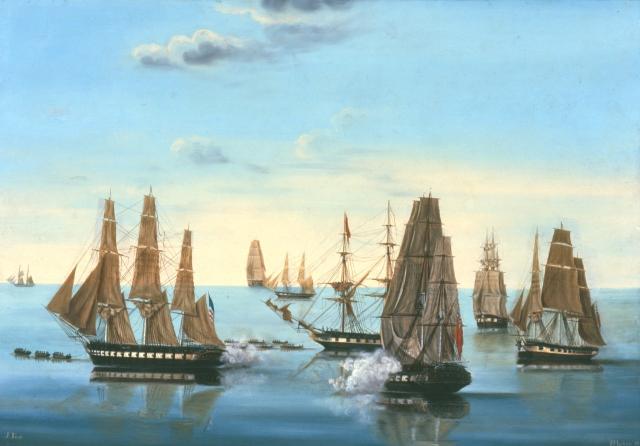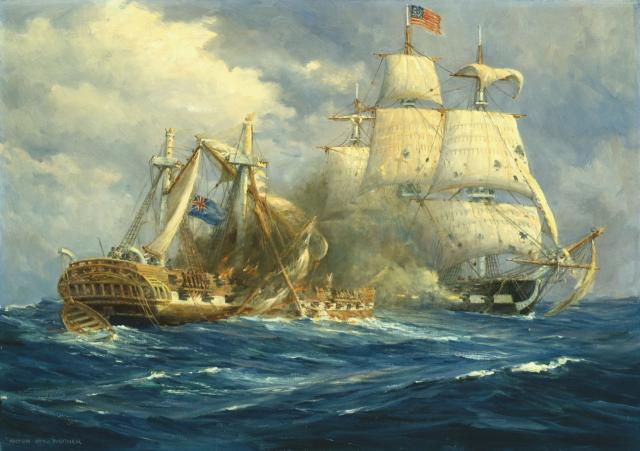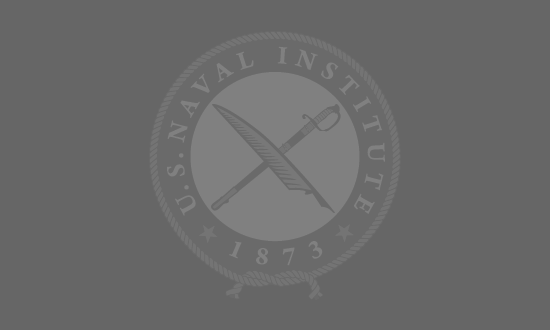Cooler heads and a different world situation might have prevented this unfortunate—and largely indecisive—clash, but these “brethren” fought a war named for one year that actually stretched over two-and-a-half. Before the Treaty of Ghent was signed on Christmas Eve of 1814, both sides had suffered humiliations each would prefer to forget—one having its capital city occupied and burned, and the other, with the most powerful Navy on earth, losing battles to an upstart nation. It was an unhappy affair, as wars usually are, yet it would prove to be the last war these two nations would fight, and—as also usually happens in war—there were moments of glory that would contribute to national character and serve as a standard for the future.
Prelude—The Chesapeake-Leopard Affair
On the morning of 22 June 1807, the frigate Chesapeake slipped past Cape Henry at the mouth of the bay for which she was named and headed for the open sea. Snapping from her masthead in the freshening breeze was the broad pennant of Commodore James Barron, whose older brother Samuel had commanded the fourth American Mediterranean Squadron during the Barbary War. Although her captain, Master Commandant Charles Gordon, had declared the Chesapeake ready for sea, and Barron as senior officer on board had accepted Gordon’s evaluation, the frigate was less than ship-shape. Because she was transporting a number of civilian officials to the Mediterranean, her decks were cluttered with their furniture and other personal effects, many of her cannon were not properly mounted, and most of the crew did not yet know where their battle stations were. But the United States was not at war, and there was a long voyage ahead, time for Gordon to prepare her for duty as they crossed the ocean.
As the frigate passed by a squadron of Royal Navy ships lying at anchor in Lynnhaven Bay, Barron noticed a flurry of signal flags running up and down several of the British ships’ halyards. Soon thereafter, the 50-gun frigate Leopard weighed anchor and followed the Yankee frigate down the channel.
In mid-afternoon, when the Chesapeake was about ten miles south of Cape Henry Light, the Leopard bore down with a request to send dispatches aboard. Such a procedure was not unusual because, in this period, British and American ships often carried dispatches to foreign stations for each other. Barron gave permission to heave to in order to receive the dispatches. As the Leopard drew closer it was apparent that her gun ports were open and her cannons’ tampions had been removed. This too was not unusual; it was common practice for warships to take these precautions when drawing close to another warship. However, the same precaution apparently did not occur to Barron or to Gordon.
Instead of merely bringing aboard the dispatches, a British lieutenant presented Barron with an order from the British commander of the North American Station, requiring that British captains meeting the Chesapeake search her for deserters from the Royal Navy. The lieutenant also delivered a letter from the Leopard’s captain in which he hoped that this could be accomplished without upsetting “the harmony subsisting between the two countries.”
That order had its roots in the ongoing conflict between Britain and France. U.S. neutrality in that war allowed Yankee traders to prosper, and both sides were convinced that the Americans were aiding their enemies. Compounding these problems, the Royal Navy’s domination of the sea was not without cost, and the long periods of blockade duty and extended deployments to protect the far corners of the Empire was causing increasing numbers of desertions. Many of these deserters found employment on American ships, and the British were understandably vexed by this.
But a sovereign nation could not expect to maintain its sovereignty with any measure of credibility, much less dignity, were it to allow another nation to board and search its naval vessels, no matter how seemingly justified. So captains in the U.S. Navy were under standing orders forbidding such searches, and Barron flatly refused.
As the lieutenant was being rowed back to the Leopard, Barron wisely ordered Gordon to clear for action. Not wanting to appear provocative, however, the order was passed quietly, without the customary drumbeat summoning the crew to their battle stations. But the Chesapeake was not a taut ship, and the order was not properly transmitted. The drummer sounded his urgent beat for several seconds until he could be silenced. This not only alerted the British but added to the confusion, causing some of the American sailors to assume the order had been rescinded. Confusion reigned as the Leopard fired a shot across the Chesapeake’s bow. Moments later, a broadside erupted from the British frigate, tearing into the Chesapeake’s hull and rigging.
Several more British broadsides followed, none of which were returned. Not only were many of the American guns not mounted, but no matches could be found to fire the few that were. As the Leopard continued to fire into the Chesapeake, Barron—now wounded—ordered Gordon to strike his colors in surrender, but not before someone could “fire one gun for the honor of the flag.” Plucking a hot coal from the galley, Lieutenant William Henry Allen juggled it in his bare hands as he carried it to one of the few guns that had been prepared to fire. He touched off the shot just as the Stars and Stripes was hauled down and a final broadside erupted from the Leopard.
Four Americans died and another 20 were wounded. A British boarding party mustered the Chesapeake’s crew and arrested four men they identified as deserters from one of the British ships lying off the Virginia coast. (Only two of them actually were.) The shattered Chesapeake was then left to limp back to Hampton Roads with her tidings of humiliation.
Barron was subsequently tried by a court-martial and found guilty of “negligent performance of duty.” He was suspended from the Navy for five years without pay. One of the judges was Stephen Decatur, a fact that would have great significance years later, when the great naval hero’s life was cut short by a duel in which Barron killed him.
Of more immediate concern, however, was what this meant to the nations involved. Although many called for war against Britain, President Thomas Jefferson’s only retaliation was to order all British ships to leave American ports. For five years a fragile peace was maintained, but the so-called Chesapeake-Leopard affair would prove to be a harbinger of greater conflict as the interests of the two nations collided on the high seas.
Impressment
The ancient Greek historian Thucydides once postulated that “the strong do what they can, the weak do what they must,” and the maritime situation in the early years of the 19th century served as a classic example. Having the world’s most powerful navy, the British were in a position to deal with their desertion problem in a way that would have been impossible had the United States not allowed their already diminutive navy to deteriorate once hostilities with the Barbary powers had been suspended.
Although the British did not repeat the egregious attack on a U.S. Navy ship as it had done with the frigate Chesapeake, Royal Navy ships did continue to stop American merchant ships in search of deserters. While taking back actual deserters might be argued as legitimate, the practice was made worse by some British captains who, in need of personnel, would take Americans who were not British deserters. This practice, called impressment, became a sore point that was made worse by territorial disputes along the Western frontier, as many Americans blamed the British for increased Indian raids in that region. So-called “War Hawks” in Congress increasingly called for a more aggressive response.
The President and Little Belt
On 16 May 1811, another incident brought the two nations even closer to war. When Captain John Rodgers—commanding officer of the frigate President—learned that an American citizen had been taken from a merchant ship by the British frigate Guerrière just outside New York Harbor, he boldly put to sea in hopes of retrieving the impressed American. Encountering an unidentified ship in the dark, Rodgers was not satisfied with the answers to his questions, so he opened fire. Although indeed British, the other ship was not the Guerrière, but was the much smaller sloop-of-war Little Belt. She returned fire and, in an engagement that did not end until the light of dawn made things clearer, the British ship got the worst of it, suffering 32 casualties and heavy damage. Rodgers apologized and offered assistance, but the British captain refused both and retired to Halifax for repairs. Rodgers was commended for the action by President James Madison, and many Americans saw the incident as payback for the Chesapeake-Leopard affair.
Declaration of War
Tensions continued to rise and, before long, the War Hawks got their way. On 18 June 1812, Congress voted for war with Great Britain, though not by a wide margin.
At the time of this declaration of war, the U.S. Navy consisted of only nine seaworthy frigates and eight smaller vessels. By contrast, the Royal Navy had more than a thousand ships, including more than a hundred each of frigates and ships-of-the-line. Even though much of the Royal Navy was busy fighting and blockading the French, there were 111 British ships in the Halifax Squadron alone, seven of which were ships-of-the-line and 31 of which were frigates. These overwhelming numbers were so discouraging that a majority in Congress—including many of the War Hawks—considered any engagement at sea as futile and repeatedly voted down a series of bills calling for the construction of more ships. It was evident that fleet-to-fleet engagements were out of the question and the U.S. Navy was going to have to rely on a more cautious strategy at sea. Maritime operations likely would be limited to what naval strategists called guerre de course—attacking the enemy’s merchant shipping to impair his logistics—and any warship engagements would be limited to those when favorable—or at least acceptable—odds presented. As was the continuing practice of the day, privateers would be relied on to assist the tiny Navy in carrying out this limited strategy.
In practice, by their sheer numbers, privateers would prove more successful than their naval counterparts, eventually capturing nearly 2,000 British merchantmen. What would prove to be less important strategically, but of great value to the morale of the underdog nation, were individual engagements between the belligerents’ warships, where the results were often quite surprising. Additionally, two “fleet” battles also would take place, not on the high seas but on the strategically important lakes that separated the United States from the British-owned provinces of Canada.
Ship-to-Ship Engagements
In July, individual ship engagements got off to an inglorious start for the Americans as the brig Nautilus was captured off New York when she encountered a British ship-of-the-line and two frigates. In that same month, Isaac Hull, commanding the frigate Constitution, encountered a British squadron of seven ships. In an impressive display of seamanship, Hull barely managed to escape. It had been a very near thing, but the Constitution and her crew would live to fight another day. The British commodore had to have felt great frustration at having lost the opportunity to take one of America’s few frigates out of the war, but his lamentation would have been far greater had he known what the future held for the ship that had outfoxed him. As the War of 1812 progressed, the Constitution would provide some of the more glorious moments as the American underdogs took on the most powerful navy in the world.
On 11 July, one of the American Navy’s more junior officers, Master Commandant David Porter, while commanding the small 32-gun frigate Essex, encountered a British convoy headed for Quebec with a load of war supplies and 1,400 soldiers.
As Porter closed with the enemy convoy, he disguised his ship as a merchant vessel by ordering all gunports closed, the sails reconfigured more haphazardly, and most of his crew hidden from sight. The ruse worked, and the Essex was able to approach the convoy without raising suspicion. That night, using the cloak of midwatch darkness to his advantage, Porter brazenly inserted the Essex into the enemy convoy and managed to cut out and capture the last ship in the group. She was the Samuel and Sarah, carrying about 200 soldiers and $14,000 in cash. In the weeks to come, Porter would capture seven more merchant ships. It was already a successful cruise by nearly any measure, but the best was yet to come.
On 13 August, off the coast of Newfoundland, a lookout in the Essex’s maintop spotted a Royal Navy sloop that proved to be HMS Alert. To lure the British warship into striking range, Porter again disguised his small frigate as a merchant. Taking the bait, the Alert closed to within two miles before her captain realized his mistake. At this point, unable to flee from the speedy Essex, the Alert continued to close and opened fire. Her shots did little damage, but when the Essex retorted with a full broadside it was a different story indeed. It was a withering blast, quickly followed by several more. The battle was over in less than ten minutes when Alert struck her colors.
More good news followed a few days later, on 19 August, when Isaac Hull proved not only his excellent seamanship but his impressive combat skills when the Constitution defeated HMS Guerrière in a heated battle that sent the British frigate to the bottom and earned the American frigate the nickname “Old Ironsides” because British shot was seen bouncing off her sides.
The Constitution returned to Boston to a celebration made even more enthusiastic because her victory had come amidst a rising tide of disasters in the war on land. The conquest of Canada had gone awry as a result of poor planning and leadership. Fort Dearborn (now Chicago) had been captured by the Indians, who promptly proceeded to massacre the entire garrison. And, ironically, Isaac Hull’s uncle, General William Hull, had surrendered Detroit to the British after only a token defense.
To the British, the loss of the Guerrière came as a profound shock. The Times of London reported that it “spread a degree of gloom through the town, which it was painful to observe.”
The month of October 1812 proved to be a significant one for the U.S. Navy. On the 18th, the Americans enjoyed a short-lived victory when the sloop Wasp captured the British sloop Frolic, only to be herself captured by a British ship-of-the-line a few hours later. But a week later, American morale was given a huge boost when Stephen Decatur—hero of the Barbary War, now in command of the frigate United States—not only defeated another British frigate, HMS Macedonian, but captured her! The month ended with the sailing of the Essex, who would make a solo voyage into the Pacific where, for the next five months, she wreaked great economic havoc on the British whaling industry—capturing 12 prizes near the Galapagos Islands and recapturing an American whaler—before she was finally destroyed by two British frigates off the western coast of South America.
Cruising off the coast of Brazil in late December 1812, lookouts in the frigate Constitution sighted the tips of several masts piercing the western horizon. Her new commander, William Bainbridge, had earned the sobriquet “Hard Luck Bill” because of several misfortunes that offset an otherwise promising career. He had been forced to surrender his first command when confronted by overwhelming odds during the Quasi-War with France, was humiliatingly compelled by the Dey of Algiers to sail his frigate George Washington under Algerian colors to deliver tribute (including many animals) to the Sultan at Constantinople, and had run the Philadelphia aground off Tripoli, permitting her to be captured and his crew imprisoned. Now commanding the Constitution, Bainbridge was given a chance to repair his reputation and did so with impressive skill and courage.
As the Constitution closed the distance, it became apparent that she had encountered a large British frigate, HMS Java. A heated engagement ensued, with Bainbridge twice wounded but refusing to leave his quarterdeck. An hour into the battle, the Java had lost all three of her masts, leaving her dead in the water, and Bainbridge maneuvering his ship across his helpless adversary’s bow in a classic “crossing the T” maneuver.
The Java’s damage was substantial, and many of her crew lay dead, including her captain. Some of her guns were entangled in the rigging that had fallen with the toppled masts, but more importantly, most of her weapons were unable to bear on their enemy in their relative positions. It was time to face the inevitable and, illuminated in the late afternoon sun, the Java’s colors came down.
It was an impressive victory for the U.S. Navy—and a particularly sweet one for William Bainbridge, who had clearly redeemed himself, proving that courage and skill were worthy adversaries to jinxes and curses.
In February 1813 the American sloop Hornet sank the British brig Peacock, but the following June, the string of American victories in frigate duels came to an end when HMS Shannon defeated the frigate Chesapeake in a short but bloody fight in which American Captain James Lawrence was mortally wounded but uttered the inspiring—though in this case futile—exhortation “Don’t give up the ship” as he was carried below to die.
For the remaining year and a half of the war, no more frigate engagements took place, and the remaining ship-to-ship duels—between various combinations of sloops and brigs—were of mixed results, the Royal Navy winning several and the U.S. Navy victorious in the others.
While these ship-to-ship engagements had notable psychological significance, they were of little strategic value. Less romantic, but of greater strategic significance, were the successes of the privateers and those commerce-raiding ventures carried out by naval ships. David Porter conducted a Pacific expedition against the British whaling industry that was particularly harmful to the British economy, and the capture of 20 merchant vessels in the English Channel by Lieutenant William Henry Allen (the same man who had carried the hot coal to fire the Chesapeake’s solo shot of honor against HMS Leopard) while commanding the brig Argus, was potent both psychologically and strategically.
Freshwater Battles
Among the most important engagements in the naval war were two battles that took place on the lakes that lay between the United States and British-owned Canada. The first occurred in September 1813 on Lake Erie. In command of nine ships (none larger than a brig) Commodore Oliver Hazard Perry fought a determined battle against a squadron of six British ships commanded by a veteran of the great British victory at Trafalgar, Commodore Robert Barclay. Perry’s force mounted 54 guns to Barclay’s 64, but the American guns were heavier and could produce more firepower. Perry was victorious, sending the now-famous message in the aftermath, “We have met the enemy, and they are ours.” It was an important strategic victory, forcing the British to abandon their plans for an invasion in that theater and allowing the Americans to go on the offensive.
The other great lake battle took place nearly a year later, this time on Lake Champlain in upstate New York. Choosing the same route they had used during the Revolution—leading to the battles of Valcour Island and Saratoga—the British came south from Canada in August 1814 with upwards of 12,000 men. This force could have easily defeated the 1,500 Americans who stood in their way, but the British commander was concerned that a small American naval squadron under Master Commandant Thomas Macdonough could threaten his flank and his supply lines along the lake, so he decided to deal with that threat before proceeding on his invasion.
Macdonough, who had been with Decatur in the burning of the Philadelphia during the Barbary War, had built a “fleet” on the shores of the lake. The largest of his ships, a 26-gun corvette appropriately named Saratoga, had been completed in little more than a month, and the 20-gun brig Eagle had been completed just five days before the fleet went into action. The remainder of Macdonough’s force consisted of two other sailing vessels, the Ticonderoga and Preble, as well as ten small gunboats that were propelled by oars and carried one or two cannon each. The British flotilla consisted of a powerful 36-gun frigate, one brig, two sloops, and 12 gunboats.
The situation allowed that Macdonough had only to maintain what sea power theorist Alfred Thayer Mahan later called “a fleet in being,” whereas the British strategy dictated that they had to engage the American naval force and win a decisive victory before proceeding with their planned invasion. This meant that the British had to come to Macdonough, so for a tactical advantage the American kept his ships at anchor in close to shore with their bows and sterns securely anchored to keep them stabilized for more accurate fire. He also ordered additional kedge anchors run out both forward and aft, with the one running forward attached to the stern of the ship and the one running aft attached to the bow; this would allow the ships to be swung about, unmasking their previously unengaged batteries.
The result was another freshwater American victory after a hard-fought battle with many casualties on both sides, the British suffering double those of the Americans. The British called off this invasion as well, but the effects of this battle reverberated far beyond the lake frontier. It was one more disappointment that figured in the calculus of war.
By this time, the British Parliament and people had grown used to a see-sawing of news from across the ocean. In August 1814, they received word that their army had captured the American capital at Washington and burned a number of government buildings, including the White House itself, avenging the capture and burning of York (now Toronto) more than a year earlier. But less than a month later, a powerful British force had been repulsed at Fort McHenry in Baltimore Harbor at the same time that McDonough was winning the Battle of Lake Champlain.
Peace talks, which were by then underway in Ghent, Belgium, had previously stalled, but the Duke of Wellington, who had been offered command of the British forces in America, said that unless Britain regained “a naval superiority on the Lakes” peace should be made at once. On Christmas Eve 1814, a peace treaty was signed and the War of 1812 was over . . . almost.
Last Battles
Communications being very poor in those days, one more great battle took place at New Orleans, where future President Andrew Jackson engaged a superior British force that was attempting to capture the city. Although primarily a land battle, Jackson made good use of the few naval forces at hand. A diminutive flotilla of five American gunboats commanded by Lieutenant Thomas ap Catesby Jones, engaged the approaching British force, slowing them sufficiently to gain Jackson valuable time. Two ships, the Louisiana and Carolina, also aided Jackson in an offensive thrust prior to the main battle by firing broadsides of grapeshot into British forces along the shore. This too delayed the British, giving Jackson time to prepare his polyglot force of American soldiers, free black refugees from San Domingo, and a band of pirates for the final defense of New Orleans. The battle was a decided American victory. The British were repulsed, suffering nearly 2,000 casualties, while the Americans lost only 13 killed, 39 wounded, and 19 missing. Jackson later acknowledged that the “well directed exertions [of the naval forces] must be ascribed in a great degree to that embarrassment of the enemy which led to his ignominious flight.”
Word of war’s end had not reached seagoing forces elsewhere as well, and Stephen Decatur was forced to surrender the frigate President when he attempted to run the blockade that the British had successfully imposed on most of the Eastern Seaboard. The last battle between the two navies’ warships took place three months after peace had been signed, when the sloop Hornet captured the sloop HMS Penguin on 23 March 1815. One final clash took place at the end of June, when the American sloop Peacock (not to be confused with HMS Peacock, which had earlier been sunk by the Hornet) took the British East India Company’s brig Nautilus after a brief engagement.
There is an old maxim that declares “perception matters more than reality.” This was certainly true with regard to the War of 1812. In years to come, Americans would forget that this war was probably preventable, that it ended more as a draw than a clear-cut victory for either side, and that, in the end, little was decided. They would suppress memories of their capital city in flames and focus on the fact that the fledgling nation had ultimately held its own against a powerful European nation (for the second time). That intrepid American sailors had defeated elements of the vaunted Royal Navy also played no small role in that perception. Coupled with the earlier exploits of John Paul Jones and other heroes of the Revolution, Quasi-War, and Barbary Wars, it was clear that the U.S. Navy would be a force to be reckoned with in the future. More prescient eyes might also have seen that this was the beginning of a gathering transition that would someday lead to the offspring inheriting the mantle of the parent, when the United States Navy would surpass Great Britain as the world’s preeminent sea power.



